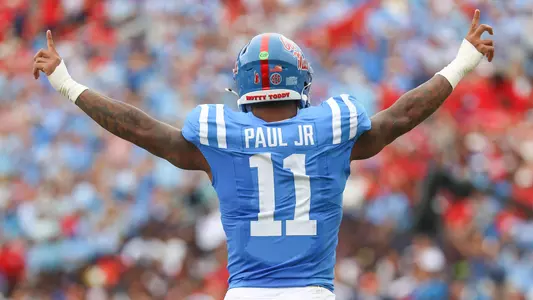The San Francisco 49ers have consistently shown a strategic interest in prospects from the University of Mississippi, a trend underscored by their recent pre-draft visits with standout players like linebacker Chris Paul Jr. and defensive tackle Walter Nolen. This focus prompts a deeper exploration: what makes Ole Miss recruits so appealing to the 49ers’ front office, and how does this strategy align with their long-term goals?

Ole Miss: A Proven Talent Pipeline
Ole Miss has earned a reputation as a breeding ground for NFL-caliber talent, producing athletes who combine physical prowess with football intelligence. Over the years, the program has delivered players who transition seamlessly to the professional level, making it a reliable source for teams like the 49ers. Unlike traditional powerhouses such as Alabama or Ohio State, Ole Miss often flies under the radar, allowing savvy teams to uncover high-value prospects who may not carry the same hype but possess equal potential.
Historical data supports this approach. Ole Miss alumni like A.J. Brown (Philadelphia Eagles) and DK Metcalf (Seattle Seahawks) have become elite NFL receivers, showcasing the program’s ability to develop players who excel in high-pressure environments. Similarly, defensive standouts like Sam Williams (Dallas Cowboys) highlight the versatility and resilience instilled in Ole Miss athletes. For the 49ers, led by general manager John Lynch and head coach Kyle Shanahan, this track record provides confidence that Ole Miss prospects can adapt to their complex, high-IQ system.
Chris Paul Jr.: A Linebacker for the Future

One of the most intriguing prospects on the 49ers’ radar is linebacker Chris Paul Jr. At 6’1” and 222 pounds, Paul may not boast the prototypical size for an NFL linebacker, but his athleticism and instincts more than compensate. During his time at Ole Miss, he recorded 225 tackles, 17 tackles for loss, and 6 sacks, demonstrating a knack for disrupting plays. His sideline-to-sideline speed and ability to read offenses make him a compelling fit for the 49ers’ defensive scheme.
The departure of Dre Greenlaw, a key component of San Francisco’s linebacker corps, has left a void that Paul could fill. While some scouts note concerns about his ability to shed blocks from larger offensive linemen, the 49ers have a history of maximizing undersized linebackers. Players like Fred Warner, who has become one of the NFL’s premier linebackers under San Francisco’s coaching, serve as a blueprint for how Paul could develop. The 49ers’ defensive coordinator, known for prioritizing speed and instincts, likely sees Paul as a moldable talent capable of thriving in their system.
Walter Nolen: Bolstering the Defensive Line
In addition to Paul, the 49ers have their eyes on defensive tackle Walter Nolen, a highly touted prospect whose size (6’3”, 305 pounds) and explosiveness make him a potential game-changer. Nolen’s college stats—112 tackles, 19 tackles for loss, and 8 sacks—underscore his ability to dominate the line of scrimmage. His pre-draft visit with the 49ers signals their intent to reinforce a defensive front that has been a cornerstone of their success.
San Francisco’s defensive line, anchored by players like Nick Bosa, relies on versatility and disruption. Nolen’s combination of power and quickness aligns perfectly with this philosophy, offering the potential to collapse pockets and stop the run. By targeting Nolen, the 49ers are doubling down on their commitment to building a defense capable of controlling games, a strategy that has propelled them to multiple NFC Championship appearances.
Why Ole Miss? A Strategic Fit
The 49ers’ preference for Ole Miss prospects extends beyond individual talent to the program’s broader culture. Ole Miss competes in the ultra-competitive SEC, facing top-tier opponents week after week. This environment hones players’ resilience and prepares them for the NFL’s physical and mental demands. Additionally, Ole Miss’s coaching staff emphasizes fundamentals and adaptability, traits that resonate with Shanahan’s detail-oriented approach.
Comparatively, while programs like Georgia or Michigan produce NFL-ready talent, the 49ers seem to value the unique blend of grit and upside found in Ole Miss recruits. These players often enter the draft with less fanfare, allowing San Francisco to secure high-potential athletes in later rounds—a hallmark of Lynch’s draft philosophy. The 49ers’ success with players like George Kittle (Iowa) and Brock Purdy (Iowa State), both from less heralded programs, suggests they prioritize fit over pedigree, a mindset that aligns with their Ole Miss focus.
Potential Risks and Considerations
No draft strategy is without risks, and the 49ers’ emphasis on Ole Miss prospects carries some uncertainty. For instance, Chris Paul Jr.’s smaller frame could pose challenges against bigger, more physical offenses, particularly in the NFC West, where teams like the Los Angeles Rams employ robust offensive lines. Similarly, Walter Nolen, while dominant in college, must prove he can maintain his explosiveness against NFL-level competition.
Moreover, by focusing heavily on one program, the 49ers risk overlooking talent from other schools. Programs like LSU, Clemson, and Oregon have produced players who could address San Francisco’s needs just as effectively. Balancing their Ole Miss interest with a broader scouting approach will be critical to maximizing draft value.
Looking Ahead: A Calculated Gamble
The 49ers’ pursuit of Ole Miss prospects reflects a calculated strategy rooted in trust in their scouting process and development system. By targeting players like Chris Paul Jr. and Walter Nolen, they aim to address immediate needs while building for the future. If these prospects pan out, they could become cornerstones of a defense poised to remain elite for years to come.
As the NFL Draft approaches, it will be fascinating to see how San Francisco’s strategy unfolds. Will their Ole Miss gambit pay dividends, or will they pivot to other programs in search of the next breakout star? One thing is certain: the 49ers’ front office has a clear vision, and Ole Miss is a key part of it.
What do you think of the 49ers’ approach? Should they continue to lean on Ole Miss talent, or should they cast a wider net? Share your thoughts below!